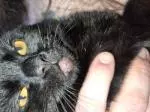The Dangers of Cat Parasites and How to Spot The Signs
Cat parasites. Not a pretty thought, is it? Still, as a cat parent, it's important to understand what to expect with respect to the health challenges your cat may face.
While not usually fatal, parasites can cause some serious damage. If left untreated, they not only sap your cat of energy, they can be down right dangerous.
Here are some of the more common feline parasites and associated warning signs. Be alert to the fact that some of the larvae of these creatures can eat holes in your cat's tissues, including skin, leaving your cat exposed to possible infections that could be life threatening.
In addition, many cat parasites can cause excessive vomiting and diarrhea, which leads to dehydration. Dehydration is highly dangerous. As always, if you suspect your cat has a disease, contact your veterinarian immediately.
Worms in Cats
Hookworms, tapeworms, roundworms and whip worms are some of the common worm-type cat parasites. They are thieves. They either swim in the gut, or attach to the intestinal wall and rob your cat of blood and/or nutrients. While most healthy adult cats can appear totally healthy with mild infestations, these nasties can cause serious illness if left untreated.
Signs and symptoms of various worms include anemia, excessive vomiting, failure to grow, weakness, weight loss, a pot-belly, diarrhea, and constipation. Testing should be done at least once a year at your cat's annual check up.
Treatment of cat worms may involve multiple treatments, and environmental and other preventative measures may be required (such as control of the flea population. Fleas = tapeworms). Death is possible with some of these infestations, especially in kittens or ailing cats.
Fleas in Cats
Fleas are small, annoying insects which feed on your cat's blood. They may, in some cases, cause severe discomfort to your cat. They also may jump on a human if the mood is right. Symptoms of flea infestation include itching, and your cat may be scratching or licking excessively.
You normally will not see fleas until they become adults, and then it is too late. Fleas lay eggs on your cat, which then fall off and go through a growth cycle, until they become adult fleas.
Fleas have been known to ingest tapeworm eggs. If your cat ingests the flea, your cat may get tapeworm.
Historically, we've been told to treat the cat, and also treat the pet's living environment in order to kill the fleas and get rid of the eggs. This includes the entire house and yard, and getting into the crevices to remove flea eggs.
Ticks
Ticks are tough little creatures that feed on your cat's blood. They attach themselves to the skin and fill up with blood over a period of time. They often carry serious viral diseases such as Lyme disease and Rocky Mountain spotted fever. If you spot a tick, remove it as quickly as possible.
Years ago, people use to recommend burning ticks to remove them. This is a bad idea. In order to remove a tick, use strong tweezers to grab the tick as close to your cat's skin as possible. Pull the tick's head and body away from the skin, making sure not to make any twisting motion. You do not want to split the tick in two, but instead remove the head and mouth completely. If you see one tick, there may be more. Check your cat and your cat's living environment thoroughly.
Lice in Cats
Lice are small, wingless insects, and live their lives out on their hosts. Both lice and their eggs can be seen with the naked eye. There are different types of lice. Those that suck blood (biting lice) may cause anemia. Others will chew skin.
The most common symptom will be a scruffy coat, with possible hair loss. There may be excessive itching. Transmission is by direct contact, either with an infected pet, or grooming brushes and combs.
Lice lay eggs, or nits, on the hair shaft, and it is more common to see the nits than the lice themselves. There are a number of treatments than can be used, including Frontline. Consult your veterinarian on exact treatment for your cat's particular case.
Ear Mites in Cats
Ear mites are tiny crab like parasites that usually live in and around a cat's ears and head. If left untreated, they can cause secondary bacterial and yeast infections in your cat. In extreme cases, they can cause a rupture of the ear drum, which may lead to seizures and deafness.
Feline ear mites are the most common cause of outer-ear inflammation in cats. Frequent scratching of the ears and head shaking are the most common symptoms. The obvious sign is a build up of dry, black wax that resembles coffee grounds.
Giardia
Giardia is another of the common cat parasites, but is relatively rare in healthy cats. It is a protozoa, and therefore is a single-celled parasite. It occurs in humans as well as cats and is a common cause of diarrhea in travelers.
These microscopic parasites cause an intestinal infection known as Giardiasis. This results in an acute case of foul-smelling diarrhea, with soft to watery stool containing mucus. Occasionally, bowel movements may contain blood. Vomiting may also occur.
Your veterinarian will prescribe anti-parasitic treatment along with methods to counteract dehydration, which may be life-threatening if not addressed.
All of the above cat parasites can be treated, and if your cat has any of them, a consultation with your veterinarian will give you your options.
More reading on cat parasites:
Cat Toxoplasmosis
Here is an in-depth look at another parasitic condition cause by a single-celled parasite, Toxoplasma gondii (T. gondii).
Toxoplasmosis and Pregnancy
Here is some information on the toxoplasmosis-pregnancy controversy.
Cat Health
Cat Illness Symptoms
Cat Lovers Only



Comments: What do you think?
Have your say about what you just read. Leave me a comment in the box below.